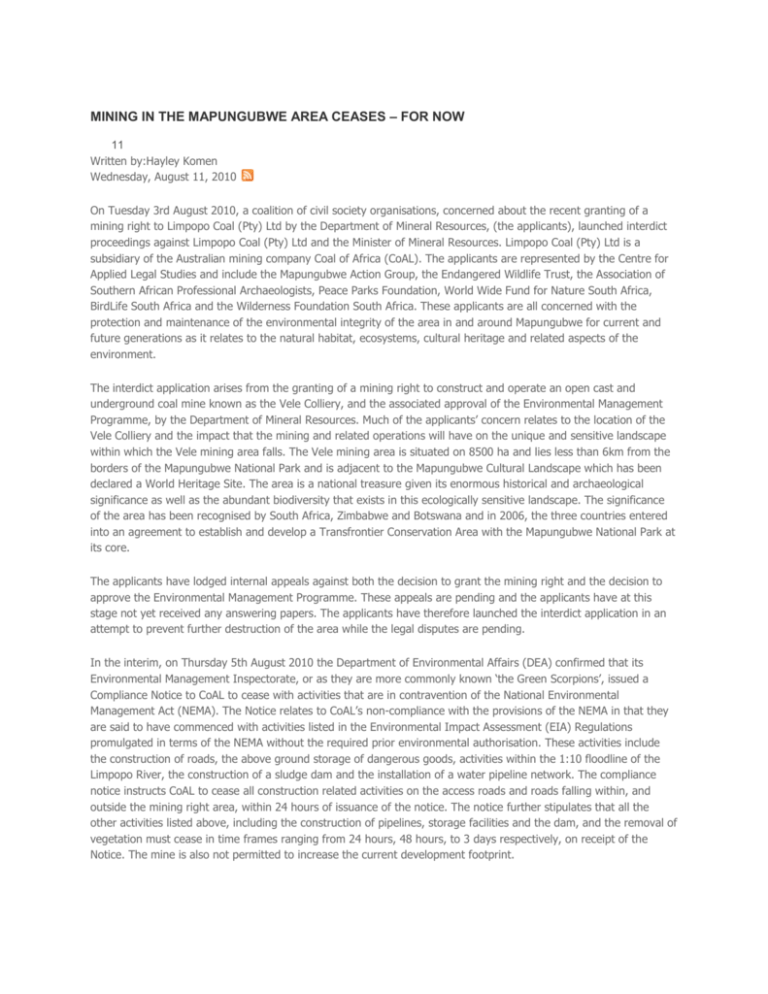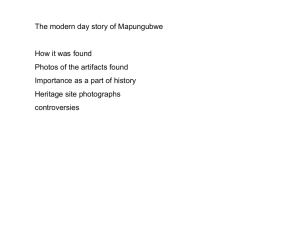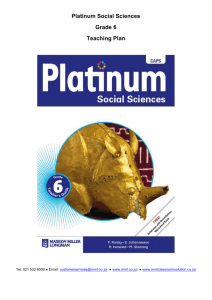mining in the mapungubwe area ceases – for now
advertisement

MINING IN THE MAPUNGUBWE AREA CEASES – FOR NOW AUG11 Written by:Hayley Komen Wednesday, August 11, 2010 On Tuesday 3rd August 2010, a coalition of civil society organisations, concerned about the recent granting of a mining right to Limpopo Coal (Pty) Ltd by the Department of Mineral Resources, (the applicants), launched interdict proceedings against Limpopo Coal (Pty) Ltd and the Minister of Mineral Resources. Limpopo Coal (Pty) Ltd is a subsidiary of the Australian mining company Coal of Africa (CoAL). The applicants are represented by the Centre for Applied Legal Studies and include the Mapungubwe Action Group, the Endangered Wildlife Trust, the Association of Southern African Professional Archaeologists, Peace Parks Foundation, World Wide Fund for Nature South Africa, BirdLife South Africa and the Wilderness Foundation South Africa. These applicants are all concerned with the protection and maintenance of the environmental integrity of the area in and around Mapungubwe for current and future generations as it relates to the natural habitat, ecosystems, cultural heritage and related aspects of the environment. The interdict application arises from the granting of a mining right to construct and operate an open cast and underground coal mine known as the Vele Colliery, and the associated approval of the Environmental Management Programme, by the Department of Mineral Resources. Much of the applicants’ concern relates to the location of the Vele Colliery and the impact that the mining and related operations will have on the unique and sensitive landscape within which the Vele mining area falls. The Vele mining area is situated on 8500 ha and lies less than 6km from the borders of the Mapungubwe National Park and is adjacent to the Mapungubwe Cultural Landscape which has been declared a World Heritage Site. The area is a national treasure given its enormous historical and archaeological significance as well as the abundant biodiversity that exists in this ecologically sensitive landscape. The significance of the area has been recognised by South Africa, Zimbabwe and Botswana and in 2006, the three countries entered into an agreement to establish and develop a Transfrontier Conservation Area with the Mapungubwe National Park at its core. The applicants have lodged internal appeals against both the decision to grant the mining right and the decision to approve the Environmental Management Programme. These appeals are pending and the applicants have at this stage not yet received any answering papers. The applicants have therefore launched the interdict application in an attempt to prevent further destruction of the area while the legal disputes are pending. In the interim, on Thursday 5th August 2010 the Department of Environmental Affairs (DEA) confirmed that its Environmental Management Inspectorate, or as they are more commonly known ‘the Green Scorpions’, issued a Compliance Notice to CoAL to cease with activities that are in contravention of the National Environmental Management Act (NEMA). The Notice relates to CoAL’s non-compliance with the provisions of the NEMA in that they are said to have commenced with activities listed in the Environmental Impact Assessment (EIA) Regulations promulgated in terms of the NEMA without the required prior environmental authorisation. These activities include the construction of roads, the above ground storage of dangerous goods, activities within the 1:10 floodline of the Limpopo River, the construction of a sludge dam and the installation of a water pipeline network. The compliance notice instructs CoAL to cease all construction related activities on the access roads and roads falling within, and outside the mining right area, within 24 hours of issuance of the notice. The notice further stipulates that all the other activities listed above, including the construction of pipelines, storage facilities and the dam, and the removal of vegetation must cease in time frames ranging from 24 hours, 48 hours, to 3 days respectively, on receipt of the Notice. The mine is also not permitted to increase the current development footprint. The applicants have heard from a number of sources that CoAL has already ceased much of its activity on the Vele site, which offers welcome but possibly only temporary relief from the ongoing destruction of this site which began with the commencement of the construction activities. The Green Scorpions will be monitoring the Vele Colliery as failure to comply with the instructions in the Notice would result in further charges to the criminal investigation that is already underway. Commencement of an EIA listed activity without an environmental authorisation constitutes an offence in terms of Section 24F of the NEMA. Upon conviction for such an offence, a person is liable to a fine not exceeding R5 million or to imprisonment for a period not exceeding 10 years or to both such fine and such imprisonment. Coal of Africa can object to the compliance notice and request a suspension from the Minister of Water and Environmental Affairs in relation to all or some of the instructions set out in the notice. However, the instructions in the compliance notice must be complied with pending the outcome of any suspension or objection application to the Minister. The applicants are delighted that construction activities on the Vele site appear to have stopped as the damage done to this site on a daily basis over the past few months is largely irreversible. We fully support the action taken by the DEA to enforce the regulations under the NEMA and to demonstrate that their role as custodians of South Africa’s precious natural and cultural heritage is not to be taken lightly. South Africa has a powerful suite of environmental legislation which is too often flouted in the face of short-term commercial gain and at the cost of the right of future generations to also benefit from our remarkable natural wealth. We are therefore pleased with the stance taken by the DEA and hope that this is a small beacon of hope for this area, and many other sensitive landscapes under similar threat in South Africa. Please support the fight to save Mapungubwe and its surrounding area for current and future generations from this and many other potential mining threats. Visit www.savemapungubwe.org.za and www.ewt.org.za for a copy of the compliance notice and photographs and information on how you can help. Yolan Friedmann Chief Executive Officer The Endangered Wildlife Trust Email:yolanf@ewt.org.za www.ewt.org.za Tel: +27 (0)11 486 1102 Werner Myburgh Chief Executive Officer Peace Parks Foundation Email:wmyburgh@ppf.org.za www.peaceparks.org Tel: +27 (0)21 880 5100 Andrew Muir Chief Executive Officer Wilderness Foundation Email:andrew@sa.wild.org www.wildernessfoundation.org.za Tel: +27 (0)41 373 0293 Mark Anderson Executive Director BirdLife South Africa Email:director@birdlife.org.za www.birdlife.org.za Tel: +27 (0)11 789 1122 Nick Hiltermann Mapungubwe Action Group Email:nick.hiltermann@telkomsa.net Tel: +27 (0)11 706 9483 Natalie Swanepoel Association of Southern African Professional Archaeologists Email:swanenj@unisa.ac.za www.asapa.org.za Tel: +27 (0)12 420 6348 Mark Botha Head: Living Lands Unit WWF-South Africa Email:mbotha@wwf.org.za www.wwf.org.za Tel: +27 (0)12 888 2830 Background This coal mine is of grave concern to the civil society organisations due to their concerns for the sensitive landscapes in and around of the mining area; the statutory prohibition against mining on those portions of the mining area that have been proclaimed nature reserves; the archaeological and other heritage resources affected by the mining; the impact on biodiversity and specifically on habitat, ecosystems and various species in the mining area; the impact on the quantity and quality of water resources; the noise and dust pollution that will be caused by mining; and the impact on the socio-economic conditions of persons affected by the mining operations, including such persons’ rights, under section 24(a) of the Constitution, to an environment that is not harmful to their health and well-being. Furthermore, concern has been raised for the failure of the EMP approval process to comply with the public consultation required in terms of the Act in that relevant persons and communities, including affected parties in Zimbabwe and Botswana (which border this mine) were either ignored or their specific concerns ignored, or they were not consulted at all when they should have been. The Mapungubwe Cultural Landscape (MCL) was recognised in 2003 as a World Heritage Site under the Convention Concerning the Protection of the World Cultural and Natural Heritage, adopted by the General Conference of United Nations Education, Scientific and Cultural Organization (UNESCO) on 16 November 1972 (the World Heritage Convention) as it is considered to have “outstanding universal value”. The MCL was the original location of farreaching cultural and social changes in southern Africa between AD 900 and 1300 and its remains are a remarkably complete testimony ... of the ... largest kingdom in the African sub-continent. Further, Mapungubwe represents “a significant stage in the history of the African sub-continent”, and therefore, the significance of preserving the Mapungubwe Cultural Landscape, both to South Africa and the world at large cannot be overstated. The Greater Mapungubwe Transfrontier Conservation Area (originally known as the Limpopo-Shashe Transfrontier Conservation Area) was established by means of a Memorandum of Understanding between the governments of South Africa, Botswana and Zimbabwe on 22 June 2006. In terms of this agreement, the three governments commit to attempting to establish a Transfrontier Conservation Area (TFCA) that includes Mapungubwe National Park and the core area properties. It was renamed the Greater Mapungubwe Transfrontier Conservation Area on 19 June 2009 and although the proposed mining area is not within the proposed Greater Mapungubwe TFCA, it is almost surrounded by the TFCA. The entire northern border of the mining area along the Limpopo River is directly adjacent to the Zimbabwean portion of the TFCA and falls within the proposed phase 2 of the TFCA. The impact of the mining activities on this sensitive landscape is best described in terms of the impact on its “sense of place”, derived from this unique natural environment, and enhanced by the distinctive mix of natural and cultural features in the landscape. An extract of the EMP submitted by CoAL describes this as: “Visiting the area is an experience of calmness. Together with the generally low presence of people in the area, the Mopane veld with the isolated occurrence of Baobab and Granite koppies gives a distinct character to the stretched out plains of the study area. The sense of place can be described as quiet and peaceful. Night time experiences are very quiet with complete darkness during moonless nights. This allows for excellent views of the night skies and the brightness of stars contrasted against the black of darkness. The visual qualities of the environment and the particular sense of place leave one with a good perception of the area, which is quite vulnerable to the introduction of mining and industrial activities.” Of significance are the concerns that this mine will result in irreparable damage to the archaeological and palaeontological heritage resources which make this region so unique. The open-cast activities will, according to the EMP itself, result in the “total destruction” of any surface and sub-surface heritage resources and palaeontological remains that might exist on the land in question and the head of the decline shaft for the underground shaft appears to be at or very near the concentration of at least four heritage sites identified as a “an extended Middle Iron Age site”. Rock art experts feel that the area has been insufficiently surveyed for rock art and that the potential impact of dust, vibrations and a change in the water table on rock art in the surrounding area, has not been dealt with adequately. The Mapungubwe area is one of only a handful of places in sub-Saharan Africa where rock paintings and rock engravings co-occur in the same landscape. The farms immediately north and west of Vele have been extensively surveyed for rock art and almost every farm has been shown to have rock art. Well known and important rock art sites immediately north and west of Vele will be impacted in serious and unacceptable ways, by the proposed mining work at Vele and any unknown sites at Vele will be destroyed should mining be allowed to proceed. The Mapungubwe Cultural Landscape is an important part of South and southern Africa’s heritage and is part of South Africa’s national estate. Indeed, its designation as a World Heritage Site underscores its internationally recognised importance for informing us about early state formation processes in Africa and the important insights that the Mapungubwe hilltop and its related sites hold for our understanding of southern Africa’s history. Threats to the water resources are also significant and include acid mine drainage, surface and groundwater contamination, impacts on the quality and quantity of water on the Zimbabwean side of the Limpopo River, the impact of water abstraction on the boreholes situated along the Limpopo floodplain and the damage and loss to irrigation farmers (with associated impacts on food security) on both sides of the Limpopo River. Note for Editors: http://www.thepresidency.gov.za/main.asp?include=orders/main.html The Order of Mapungubwe Mapungubwe A millennium ago, the amazing Kingdom of Mapungubwe existed in the northern corner of South Africa. It comprised a sophisticated state system, with highly developed agriculture, mining, and metallurgy industries. The Kingdom traded with countries as far afield as China. According to the Archaeology Department at the University of the Witwatersrand, Mapungubwe represented 'the most complex society in Southern Africa'. It is reputed to be the origin of the people, culture and foundation for the achievements of Great Zimbabwe. Mapungubwe Hill is a sandstone hill located on a mudstone deposit in the northern part of the Limpopo province, known for its arid subtropical climate and erratic summer rains. Out of this seeming barrenness, like an oasis in the desert, there blossomed the complex and highly developed state and culture, centred around a thriving town built on and around Mapungubwe Hill, which served as the capital of the ancient Mapungubwe Kingdom. The Order of Mapungubwe is awarded to South African citizens for achievements that have impacted internationally and served the interests of the Republic of South Africa. The first and highest category of this Order is awarded in platinum for unique and exceptional achievement; which the secondhighest category is gold. The third category in this order is sliver, awarded for excellent achievement; and the fourth is bronze for outstanding achievement. This Order is awarded to South African citizens for excellence and exceptional achievement.





